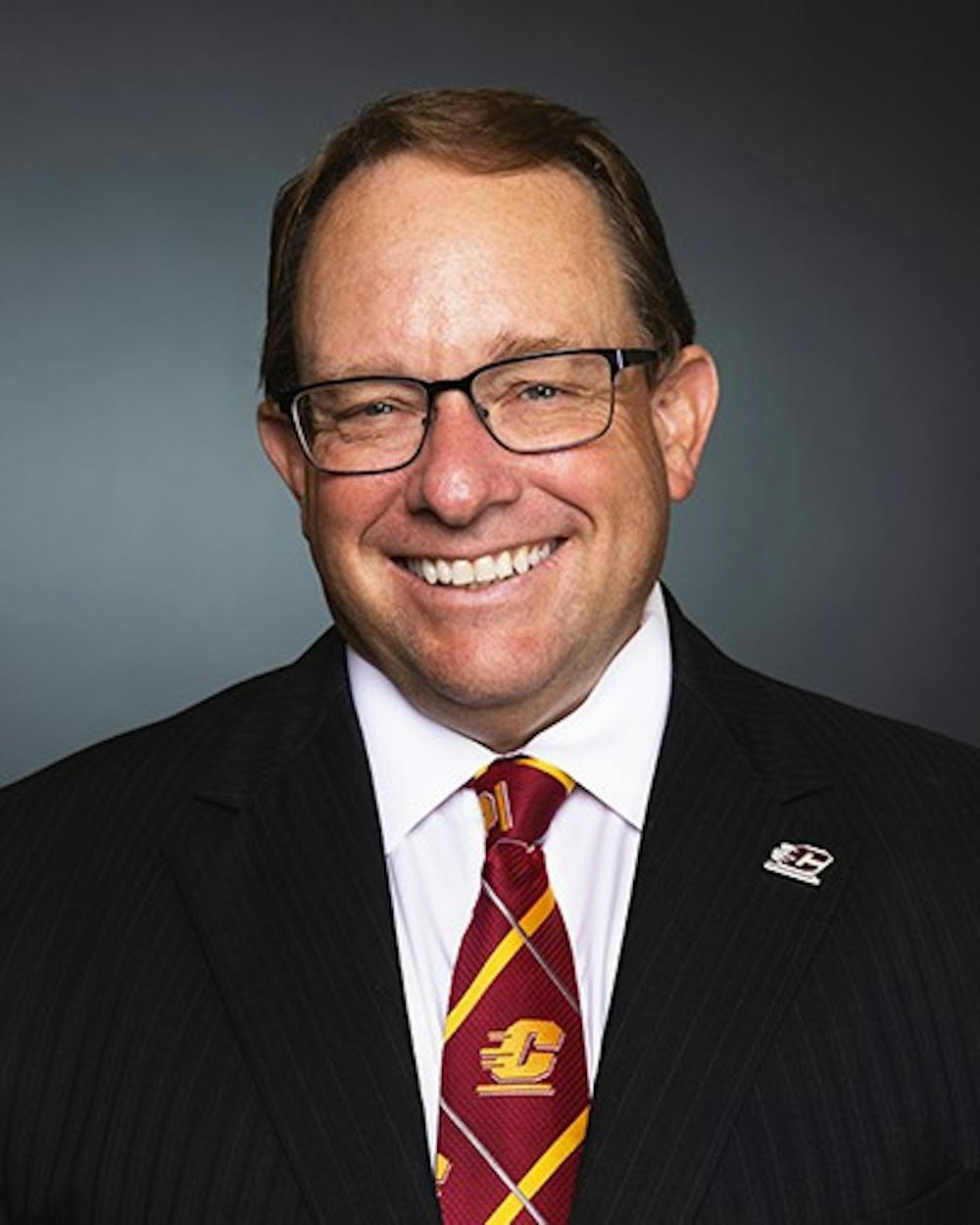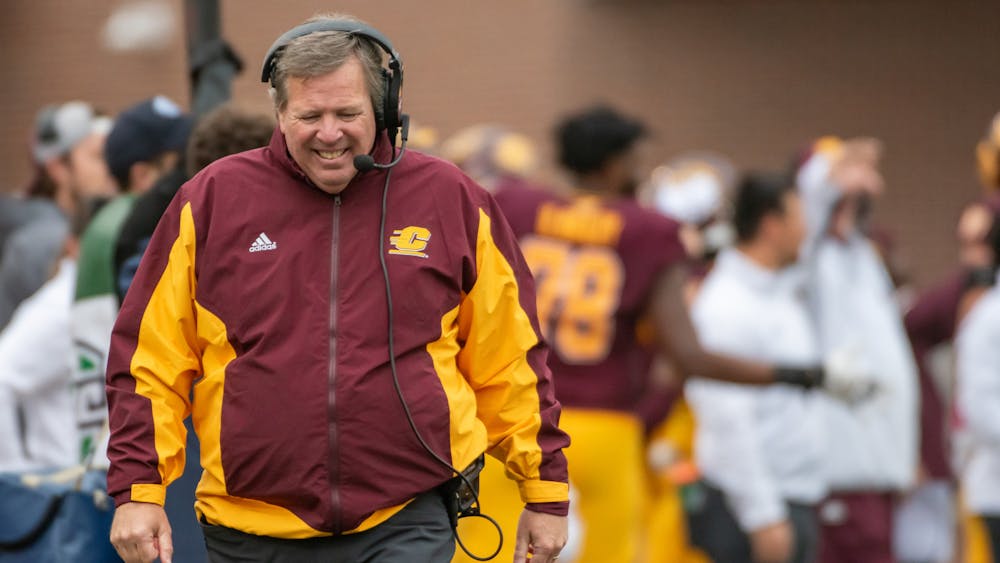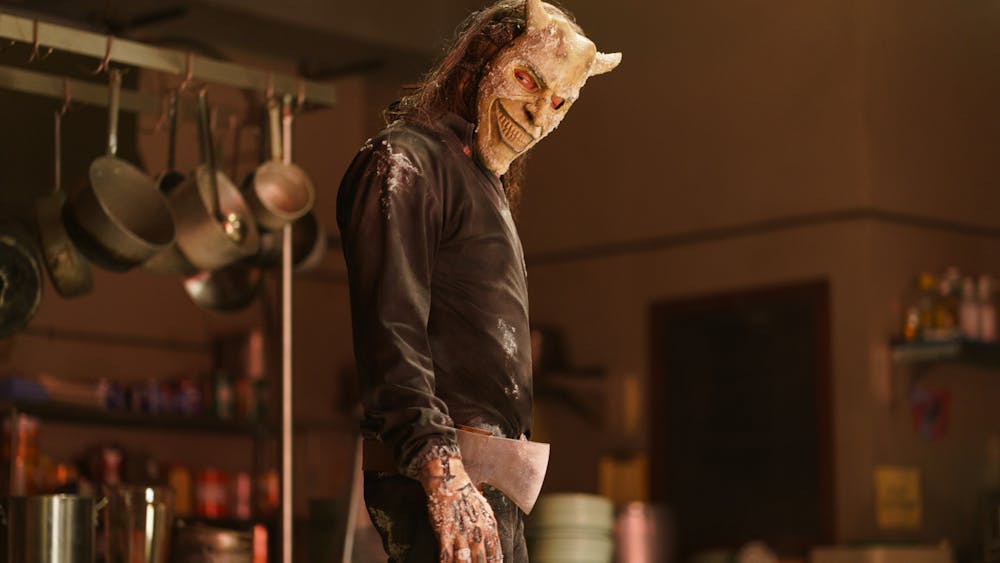Q&A: President Davies 'in it for the long haul,' addresses campus issues over past academic year
EDITOR'S NOTE: Responses are edited for length and clarity.
The end to a “stressful” academic year at CMU is just days away. Over the last 12 months the university has made state-wide and national headlines over decisions about CMU’s future.
Just coming out of the COVID-19 pandemic, CMU President Bob Davies now finds himself responding to concerns from all across campus. Students, faculty and staff have demanded for their voices to be heard when it comes to topics ranging from enrollment to diversity efforts to dining halls.
For Davies, it’s been a year of tough decisions. Regardless, he said he’s confident about CMU’s future and is “in it for the long haul.” He looks forward to improving communication with the campus community post-pandemic. He said while CMU may look different five-to-ten years down the line, it’s commitment to providing quality higher education will remain the same.
We're days away from the end of the academic year, how are you feeling right now?
I'm tired and excited.
Last week at the Board of Trustees, I went through a lot of the awards in research from our faculty and some of our amazing student scholars. I'm very excited about the civic engagement and increases in voter participation around campus. I'm grateful for the support from students, faculty staff and alumni.
There's a lot to be excited about, but I'm tired. We all have to admit this has been a hard year, honestly, a hard two years. This has been stressful on all of us. I hope people have the opportunity to reflect and think about what we've gone through and hopefully rejuvenate for the next academic year.
After more than a year into the "We Do" campaign and other increased marketing efforts, have we seen the results?
I think the "We Do" campaign succeeds on many marks. The brand pillars we've set up allow us to talk about what makes CMU special. It also allows every major constituency or stakeholder group to personalize it.
Here's the challenge: We launched a brand during the pandemic. So one of the things you want is for your internal stakeholders to fully understand the brand and we didn't really get an opportunity to do that. We want students, faculty and staff to learn more about the "We Do" campaign and be able to use it to promote their excellence. Do I think it's hitting on all the cylinders, in some cases, it's doing really well but we need the audience more engaged in the process. I absolutely think it's worth the resources.
The Board of Trustees has put a lot of effort into the Washington Commons project but it has received criticism from students and faculty. Would you have done anything differently to present the project?
I think there are some things we could have communicated a little stronger. But I want to make it clear that we have paused the project based on feedback we've received. Some aspects are moving forward like Lot 75 but it's not a replacement for Lot 22.
When we think about Washington Commons, a lot of the discussions have been around affordability, parking, and safety - all of those are important to this project. One thing that often gets lost is that Kewadin Village and Northwest Apartments have outlived their useful lives. If we do nothing, in three or four years they will not be available at all. So we have to do something.
When taking public comments about Washington Commons specifically, every question gets logged. One thing that I do and that the president's cabinet members do is we seek input from all stakeholders. Sometimes that's town hall forums but we also have formal committees and workgroups and informal methods like having lunch with students and talking to campus community members.
Many faculty members have said they lack a voice in university decisions. Has shared governance improved over the past year? What have you been doing with faculty feedback?
I think shared governance is different depending on the campus. I met with the faculty at the beginning of the year and I learned some things about our academic senate. Hopefully they also learned some things about my view on shared governance.
I think they were surprised to learn that I do not vote on academic and curricular matters. I don't think that's my charge as president. At the same time, they encouraged me to be part of the debate on certain aspects – and so I've done that...
...I think (shared governance) has improved. There's steps that I've taken to engage shared governance in a different manner, i think others have as well.
Ultimately, we all have the same goal. We want to improve CMU. We want to maintain a rigorous and relevant academic program for our students. We all want to have additional students come to CMU. Do we always agree on how to get there? That's part of the fun. That's part of shared governance.
Students also haven't been shy with sharing their concerns, particularly with the dining services switch last semester. Knowing what you know now, would you change anything about the switch? Are you ultimately happy with Chartwells so far?
I know of very few universities, if any, that did not have dining challenges due to the pandemic. I don't know if I follow the hypothesis, 'if we would have stayed with Aramark, everything would have been fine.' There are universities that use Aramark in Michigan that had the same problems we did. There were also issues with Aramark at CMU that were pre-pandemic.
Chartwells seemed like they would listen to students more. I think they've done that with the selection of restaurants down in Central Eats. When they heard students ask for more plentiful food, they tried to meet that, But it also meant other sacrifices. The decision to use next year to renovate North was part of the discussion. As we go forward, having four cafes open at the same time was a stretch for the next academic year. Now to solidify and have three cafes means they will be able to provide more full-time services.
Chartwells is more creative with their food so I think there are definitely a lot of benefits there.
Name some specific examples of times you used student input to make decisions.
I've already mentioned the consolidation of our restaurants and COVID policy was done with students in mind. I meet with SGA President Kate King regularly and she recently highlighted some issues with the food pantry that we were able to solve.
We have emphasized in our fundraising efforts, the need for the student emergency fund which also came from student interaction. We created the "Finish Up Chips" scholarship after I spoke with students about why they stopped attending CMU.
Shawna Patterson-Stevens is working with a group of students on our DEI efforts. The Diversity Symposium and Diversity Gala that are being held later this week is a direct reflection of some of that input.
We've observed plenty of turnover in administration over your four years here. How do you preserve institutional memory when you have many people leaving?
I work with a lot of faculty and staff who've been around a long time. There are times when I'm facing a decision, and I will call them and run things past them. They provide wonderful advice and wisdom. I also go to the archives frequently and ask questions and get a sense of the past.
When a president comes in they try to get their team together. I've been very diligent about that. I wanted a team that works hard for their particular division and a team that works hard for everyone. I stress to them the importance of advancing the university.
I take ideas I've learned at other institutions but I never apply them directly at CMU. I take concepts, thoughts, and parameters and I ask, 'how would this work here?'
The pandemic put a critical need on communication. I'm not going to say institutional memory was lost but the ability to have direct communication that really gets to the emotions has been a challenge.
CMU got media attention from outside Mount Pleasant recently. You addressed articles from the Detroit News and Bridge. What gets left out of media coverage about CMU's challenges?
I wanted to make sure that our constituencies our faculty, staff, students, alumni, potential students, and others had the context. The headline in the Detroit News questioned if we were viable or not. Many members of our community do not subscribe to the Detroit News so they rely on that headline and what people said about it. My message was about level-setting what the headline said.
The number of freshmen, the number of transfer students and the new incoming class are projected to increase for the first time in six or seven years. Does that solve our enrollment problem? No, we have not.
Meanwhile, we've increased our number of graduates and so I'm proud of that. But we need to get to a point where we start having the number of incoming students equal the number of outgoing students to stabilize the enrollment.
What would you like to accomplish by this time next year?
I'm looking forward to lively discussions about the future of the university. We'll look three, five, 10 years out. We haven't had as many robust discussions as I would have liked during the pandemic.
We've been dealing with, what's going to happen next semester? What are the protocols for, sometimes, a week later?
I want to continue pursuing our five strategic pathways. Pathways four and five, specifically deal with serving student needs and revisiting our business model are things I think we've made really good strides with.
Pathway number two deals with diversity, equity, inclusion, and making sure everyone can access the marketplace of ideas. The addition of Dr. Patterson-Stevens is dynamite. She's going to present a draft plan at the beginning of next semester for over a period of five years. I find it absolutely dynamic.
You served as Murry State's president for four years and Eastern Oregon for five. How long do you see yourself at CMU?
I'm 55 years old. I'm not looking for a fourth presidency. I want to stay here and continue to make CMU the best best place that it can be. I have the support of the Board of Trustees. I have support from a lot of faculty, staff and students.
Do I have the support of everybody? No. When you make decisions, especially the decisions that we've made over the last two years, there's going to be criticism.
I'm in it for the long haul. I'm not ready for retirement. I have a lot more gray hairs than I did when I started but that's okay. I am passionate about CMU. I'm passionate about the mission we serve. I'm passionate about the faculty, the staff, the students, the alumni, and the area.
Is CMU financially prepared to be a smaller university? Are you confident in our budget setting?
Our financial statements are strong, I think we have a really good balance sheet. We will need to continue tightening the belt. As I mentioned before, we are experiencing declining revenues so we will go through a budget reduction process.
We'll have to focus on that essence of CMU, the connection between faculty, staff, and students. We need a community that focuses on (academic) programs that students desire. We'll need to focus on programs that help students be civically engaged so that when they leave CMU they have the ability to shape and change society.
You've mentioned a lot about our DEI efforts. In your own words, what does it mean to be an antiracist? How do we put that into practice at CMU?
I really go back to Martin Luther King. I often reflect on his letters from Birmingham Jail. He puts forward this notion of laws that differentiate and laws that create sameness. He talks about laws that will lift everybody up. He talks about fellow clergymen and moderate whites that prefer to have order over justice.
To me, antiracism is that thought process Dr. King was using. We need to be thoughtful about policies and procedures that would intentionally or unintentionally differentiate us and how we can remove those.
One of our moonshot goals is that we have differential graduation rates based on race. We can't lower one and artificially boost another. So, how do we get those closer together? Very few universities have been able to do that but if CMU can be one of those few, that would be a legacy.
Can CMU be an antiracist institution and still have the Chippewa mascot?
We work very closely with the Saginaw Chippewa Indian tribe, and we do a lot of things in tandem with them. It's a very strong partnership. The tribe is very prideful in what we've been able to do they point to a lot of benefits from it.
The Saginaw Chippewa Indian Tribe leadership gets invited to high schools throughout the state that are grappling with nickname and mascot issues. We're using the name but do so in a very respectful way - and we will continue to do so.
One of the things that we're working on, is to have a much stronger representation of Native American history and traditions on campus. Obviously part of that is through the Saginaw Chippewa Indian Tribe but it would also be partnerships with other tribes throughout the state. I told the group who was working on this, I don't want this to be just pretty pictures of pow wows and things along those lines.
We need to acknowledge the industrial boarding school that's right in our backyard. Many people don't know what happened there. To me, it's about living our brand, communicating with the tribe and making sure all of their history is told.
Any advice for this year's graduating class?
I want them to think, I did not let hard times define me, I defined the times. They graduated in probably the hardest time ever with the changing dynamics, the ambiguity, the political strife, the racial tensions that needed to be addressed.
I hope you take that forward. So that whenever an obstacle comes up, you can say 'I got this.'






